Insights to improve products
The term ‘discovery’ covers a range of techniques that help product and marketing people get the insights they need to improve their products. While the word has been around for millennia, in the context of products, it was probably first coined by Marty Cagan in his book, Inspired. His choice was made, as he says, “… to illustrate the need for an open mind to know what they [Product Managers and teams] can’t know and admit what they don’t know.”
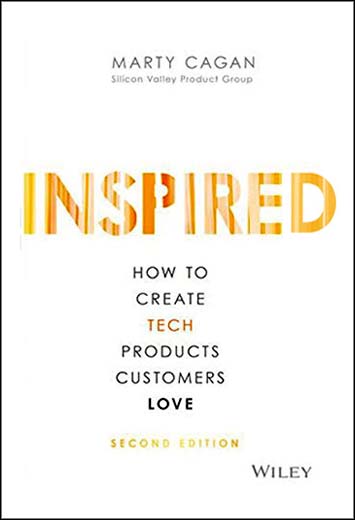
Often, we find the term used only in the context of trying to uncover breakthrough insights that can spawn great new product innovations. Although that’s a key application, the techniques are also valuable in working out where the product team should focus their efforts for incremental improvements of existing products.
It’s all about finding nuggets of insight into customer pain points and what they value. Knowing these means we can better focus our company’s limited resources on the areas that matter to customers and align with our business objectives.
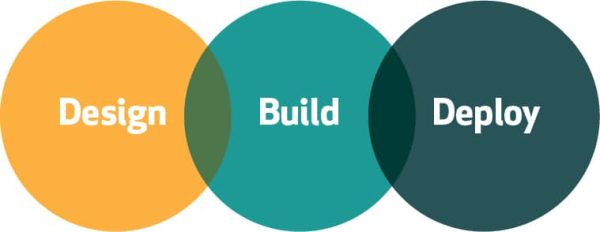
Where’s the source of insight? It starts with getting close to your customers, having empathy for them, getting immersed in their daily life, and keeping an open mind about what they do, the environment in which they operate, and why they make the choices they make.
Guiding principles for product discovery
Teresa Torres, Product Discovery Coach and Founder of ProductTalk.org has done a great job in her blog on product discovery. She identifies 6 guiding principles that help explore the problem space. A short précis is provided below, but we would encourage you to read the full blog post here. The 6 principles are:
- Start with empathy for your audience
- Explore the problem space indefinitely
- Map your way to clarity
- Use theory as inspiration
- Co-create solutions that meet the unique needs of your audience
- Surface and test underlying assumptions
1. Start with empathy for your audience
The start point for discovery is empathizing with the viewpoint of your audience. It can be tough to avoid projecting our own perceptions and making assumptions. What’s needed are unbiased insights into their motivations and context, to understand what works for them and what doesn’t.
2. Explore the problem space indefinitely
If discovery is treated as a one-off event that explores the problem space and then moves onto the phase of generating solutions, then it is easy to miss changes and nuances. Also, you’ll lack the mechanism to go back, to dive-deeper and re-clarify. There’s always more to learn and that’s why adopting continuous discovery practices is so important.
3. Map your way to clarity
Our brains are exceptionally good at spatial reasoning and so creating visuals of what has been learned helps unlock powerful insights. Maps come in all shapes and sizes: customer journey maps (that illustrate their journey to achieve a particular outcome), process maps, story maps, network maps, and so on.
4. Use theory as inspiration
It’s easy to fall into the trap of creating a solution that’s no better than what already existed. Don’t re-invent the wheel – innovate in places where better solutions are needed.
To avoid this, use theory and first principles to help frame the problems we see. This means considering human truths (e.g., psychology, biases, sociology) that are pretty stable over time. It also means considering technology truths (e.g., technology preferences for mobile vs desktop) that may change quickly.
5. Co-create solutions that meet the unique needs of your audience
When we hear a problem, too often we jump to the first solution that comes to mind and over time we fall in love with our ideas. We start failing to ask, “How is this situation different?” and what might we learn to ensure our solutions address customers’ [market] specific needs.
Teresa advocates using an opportunity solution tree, shown below, to visually map solution ideas to the opportunities found in discovery interviews as a way to guarantee that real needs are being addressed.
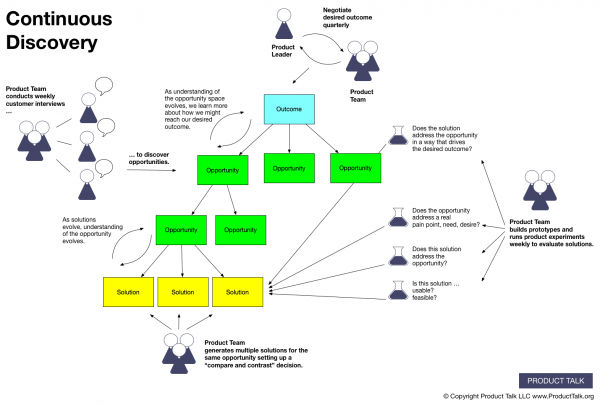
Opportunity solution tree – Copyright Product Talk LLC www.ProductTalk.org
6. Surface and test underlying assumptions
After we’ve come up with a product idea, it is tempting to leap into testing it out with a prototype or Minimum Viable Product, but it’s good to pause and reflect – product graveyards are littered with excellent technology that nobody wanted.
It will save you time and energy when you get to development if you are able to validate the assumptions behind your product idea.
For example, you might use story mapping to identify key actions that you anticipate people will take to satisfy their needs. Each action is based on an assumption – what will cause these people (actors) to take those actions? Is it realistic that they will?
Also, the success of any product depends on its desirability to users (as well as many other factors). Validating your assumptions on why your product is desirable can help you avoid adding to the product graveyard!
Techniques to help product discovery
Teresa’s post emphasizes the importance of ongoing exploration of the market problem space. There is a multitude of tools and approaches that may help do this and we’ve picked out three of these below.
Design thinking is used to explore customers’ context and challenges, Jobs To Be Done helps understand and prioritize what’s important and Design Sprints help to create and learn from a prototype in just one week.
Design thinking
Design thinking is focused on creating empathy with a customer… getting under their skin to really understand their situation, what they’re trying to achieve, how they go about it, and the problems they face. It requires using techniques such as customer interviews, ‘day in the life of a …’, and observations. During these sessions, there’s a need to work hard at undoing our in-built biases, preconceptions, and assumptions to be open and continually re-frame the problem space based on what we’re discovering.
The results are a set of unstructured observations that later need to be followed up with discussions to explore the emotional and functional needs of customers.
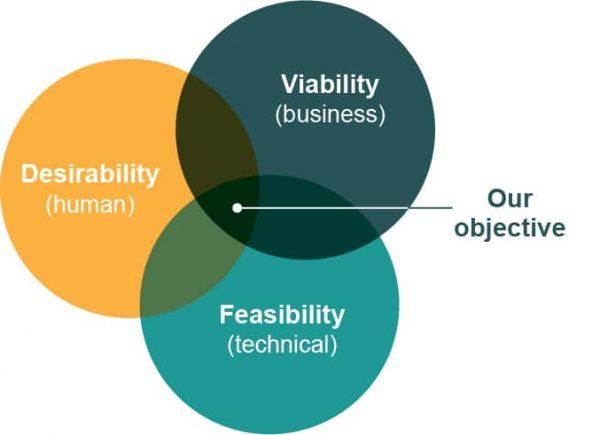
Design thinking
This product discovery is messy and the output needs refining. The outcome should not be a set of fluffy, vague statements about what customers value, but should identify the sweet spot of ideas that are: Desirable (to the customer), Viable (it makes sense for our business to build a solution), and Feasible (technically we can do it).
All sounds fine, but who do you talk to? A challenge we’ve found is product teams talk to the customers with whom they have an existing relationship – it’s the easy choice. Unfortunately, that can also mean they find the answers that they already knew. So, it’s good to work with some of the outliers, the prospects or customers that behave in a different way to the norm – these might give insights that you won’t get from the mainstream. While these need validating as representing a target market segment, having this different perspective can be great at getting ourselves out of a rut.
Doing all this work takes time and money. If speed to market is important (as it is in most markets) then it can be tricky getting a balance between how much time you spend on this research to get insights and getting going on development. What you’re aiming to do is to get enough evidence to be able to make decisions on what you think customers will value, build the minimum that will deliver this and iterate from there while continuing your process of discovery.
Jobs to be done
Jobs to be done is another technique that’s really useful at getting under the skin of customers. Its purpose is to identify the worthwhile opportunities for delivering things your customers value.
It starts with getting insight into what people are trying to achieve e.g., the outcomes they are striving for (such as a customer support team reducing their cost per call or getting feedback to tell them that they’re doing a good job). Each of these outcomes is then assessed to work out where there is an opportunity for improvement and how these might be valued by customers.
The research is based on 2-phases of analysis. It starts with in-depth research based on surveys or, ideally, one-on-one meetings. This digs into the reality for people in particular roles… their context, decisions, behaviors, and solutions (the outcomes of ‘what’ they are doing) and discussions on the ‘why’ behind what’s been observed.
The second phase is a survey of more people in similar roles so there is sufficient data to be able to draw reliable conclusions. The basic output of a Jobs To Be Done research is a graph like the one below. Each diamond represents a particular outcome and the axes of importance and satisfaction (with current ways of working) help categorize each job as being over-served, adequately served, or underserved. The underserved segments are those that are great opportunities for innovation while the other categories point to opportunities for incremental improvement in a product.

Jobs to be done
The challenge with this technique is that it takes time, expertise, and access to customers to do. So, many companies use outside agencies to run this research for them.
Design sprints
The term Design Sprints comes from Google Ventures and a playbook is provided in the book, Sprint. However, it is an approach that has worked well in many other companies – bottomless wallets are not a prerequisite!
A design sprint typically lasts a week though we’ve seen them happen over different periods from 4 days to several weeks. It involves a team of people familiar with a particular product area that come from diverse disciplines e.g., product management, Product Owners, development, customer experience, marketing… and customers willing to assess what’s been created during the design sprint.
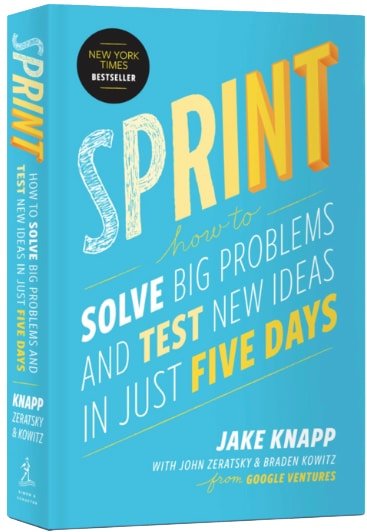
There are many positive aspects of running a design sprint. None more than the Test day. We like this for two important reasons. First, you get real customers to test and get their feedback really quickly. The whole team sees this live which makes the direct feedback really powerful. Second, you only need 5 customers to get to around 85% assurance of the feedback. So, with just 5 customers, in a week, you can determine if you’ve missed the target, discover what really matters, and find out what gets people excited.
Just one last comment – Design Sprints may only take a week to run… but they take good preparation to be worthwhile – and follow-up to build on what’s been learned!
Conclusion
Good product management is working out the right product for the business, building the product right, and helping the business to sell it. Discovery helps across all these aspects:
- Creating empathy for the customer and using these insights to drive your innovation and marketing.
- Making product decisions – what to drop, what to keep, and what to focus on.
- Being more creative during the development process and maintaining the interest and motivation of the development teams.
- Improving your market engagement by linking the customer outcomes enabled by your product to the benefits that will be talked about by Sales and Marketing.


